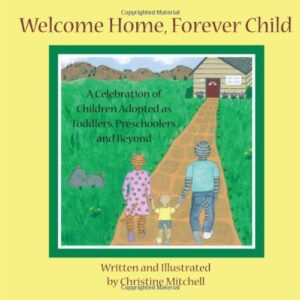Talking with Children About Adoption – This Author’s View
by Christine Mitchell, author and illustrator
Recently my daughter asked me, with a sad expression, “How come babies have to come out of their mom’s tummies?” I wondered if it was bothering her that she did not ‘come from my tummy’. I considered asking her if this was troubling her, but I didn’t want to ‘plant’ an idea if my suspicions were incorrect. If she brings this up again, I plan to say, “Some kids who were adopted are upset that they weren’t in their mommy’s tummy. Is that how you are feeling?”
A Fine Line
It is a delicate balancing act that we face, as adoptive parents, in talking with our children about adoption in general, and about their particular histories. When should we tell them they are adopted? How much do we tell them about their birth family? How do we explain why they were adopted? In our case, the first question was easy. Because our younger daughter joined our family at age four, she already knew she was adopted. She also remembers quite a bit about her birth family, although that sometimes brings more questions than answers. I still struggle with explaining the ‘why’s, because our situation is complicated – as is often the case with older child adoptions.
Start Talking to Your Child Early
The general consensus among experts and adoptive parents is that you can never start too early talking about adoption. A great way to begin, especially for very young children, is with a simple story about how much the parents wanted a child, and how joyous it was meet him and bring him home. Additionally, children’s books are an excellent avenue for introducing adoption concepts and terms. They provide a comfortable backdrop for children to voice their questions and concerns. Youngsters also find it reassuring to know that other children have been adopted as well; that they are not the only one.
What Is Our Goal?
As parents, our purpose in discussing adoption with our children is not simply to give them information. We also want to establish a two-way conversation and convey our own willingness and availability to discuss our children’s concerns and questions. Typical concerns of young children include the following:
- Wishing to look like the adoptive parents
- Sadness that he was not in adoptive mom’s ‘tummy’
- Wondering why her birth parents could not keep her
- Wondering about his ‘real’ parents; what do they look like?
- Will she be in this (the adoptive family) forever?
Older Child Concerns
Unfortunately, things are even more complicated for children adopted at older ages (beyond infancy). These children, particularly after abuse, neglect and multiple moves, may have some of the following worries and concerns:
- Will he be hurt again? Will he have enough food, clothes, and a place to live? Will someone from the past come back to hurt him or take him away? Will he have to move to another family again? Feelings of grief and loss for people and places from his past. Difficulty trusting the new adults in his life.
- Difficulty believing he will be safe.
Keep the Conversation Going
While we can and should start early in talking about adoption, it takes many years before children are developmentally ready to achieve a full understanding. Along the way we try to ensure that we are open and available for their questions, answering them in an honest yet age-appropriate manner. We try to ease their feelings of rejection by explaining that her birthparents couldn’t parent any child. We remind them that a child can love or care about two families, just as parents can love more than one child. Hopefully, along the way, our children will build that sense of well-being, and of being special, that we want so much for them.
Inspiration for Welcome Home, Forever Child
While we were preparing for my daughter’s adoption finalization, I searched for a special and meaningful book that truly celebrated older child adoption. When I didn’t find what I hoped for, I decided to write one myself. Because children adopted past infancy do have additional worries, I wanted to try to address some of them and help reassure children that they are safe, loved, and a permanent part of their new family.
As many adoption books do, Welcome Home, Forever Child expresses the longing of parents for a child, and their joy at bringing the child home. In older child adoptions, especially, we cannot ignore our child’s past. The book acknowledges that the new parents missed the child’s early milestones, like baby teeth coming in, and learning to crawl. This provides an opportunity for the child, if they wish, to express their sadness that they were not born into the family. While acknowledging this loss, the family looks forward to sharing many ‘firsts’ together, and building a lifetime of memories together. They imagine sharing activities together like reading bedtime stories, playing ‘hide-and-seek’, and building sand castles. As the family anticipates sharing experiences and milestones, the book conveys the message that whether the child is learning a new skill, or marking a new milestone… the parents will be there. They will always be a family. This is such an important message for children who have experienced multiple placements. It’s hard for them to believe they won’t have to move again, and my goal was to offer a tool to help reassure children of their permanent place in their ‘forever family’. The parents in Welcome Home, Forever Child also promise to comfort and nurture their child, especially when she is scared, sick, or injured. My daughter likes to stop at this point and scold me if I didn’t kiss her latest boo-boo.
The intention of my book is to help parents reaffirm how proud they are of their child, how much they love for him or her, and how committed they are to their child. My hope is that parents and children will enjoy the book together, and that it is useful in promoting attachment. Parents have reported that it is especially comforting at bedtime, which is often a time of increased anxiety for children. Regina M. Kupecky, LSW recently shared with me that she is using the book in her therapy practice, and that children and parents love it. I am thrilled that the book has been well received by adoption and parenting experts:
– Regina M. Kupecky, LSW, Co-author with Gregory C. Keck, P.H.D., Adopting the Hurt Child and Parenting the Hurt Child
– Foster W. Cline, M.D, Co-author with Jim Fay, Parenting with Love and Logic
– Mary Hopkins-Best, Toddler Adoption: The Weaver’s Craft






